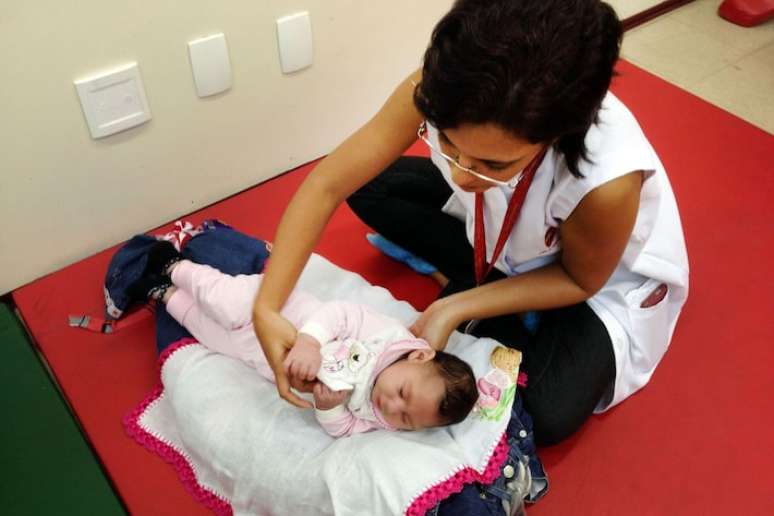Brazil has five cases of mother-to-child transmission; four children were born with malformations, but although the cause is not yet certain, an expert says it is very likely that the virus caused the pathology
Researchers from the Evandro Chagas Institute (IEC), associated with the Ministry of Health (MS)found evidence that the oropoucha fevera disease transmitted by mosquitoescan be transmitted from mother to child during pregnancy. In light of the discovery, the Ministry issued a technical note this weekend recommending that states and municipalities redouble their vigilance for the possibility of this type of transmission, called vertical transmission.
The alert was raised after the The IEC has identified the presence of antibodies against the virus in four children born with microcephalyin addition to the genetic material of the oropouche virus in a stillborn fetus at 30 weeks of gestation.
The ministry stresses that the results highlight the vertical transmission of the virus, but the limitations of the study do not allow to confirm that infection during pregnancy is the cause of neurological malformations in newborns.
The infant studies were conducted last month, when the institute analyzed samples of serum and cerebrospinal fluid (a type of fluid that protects the brain and spinal cord), collected to test for arboviruses that can affect the nervous system, but tested negative for other infections, such as Zika and chikingunya.
In addition to excluding the possibility of these diseases, the presence of other possible causes of microcephaly, such as toxoplasmosis or syphilis infections, was not identified in the mothers.
Thus, they detected the presence of IgM class antibodies against the oropouche virus in four children with microcephaly, three of them at one day and one at 27 days.
This month, laboratory investigations of a case of fetal death at 30 weeks of gestation identified genetic material from the OROV virus in the umbilical cord blood, placenta, and several fetal organs, including brain tissue, liver, kidneys, lungs, heart, and spleen. the fetus.
“This shows that vertical transmission of the virus has occurred. Laboratory analysis and epidemiological and clinical data are being carried out to definitively conclude and classify this case,” the statement reads.
Animal studies
Research carried out on animals infected by viruses of the same serological group as Orthobunyavirus Peribunyaviridae (OROV), the virus that causes oropouche fever, transmitted by mosquitoes of the same genus, has been shown to have vertical transmission of these agents, which can cause abortions and fetal malformations.
In light of these data, the Ministry specifies that the possibility of transmission of the oropucha virus from mother to child had already been considered since the first outbreaks recorded in Brazil. However, the ministry emphasizes that, so far, there is no solid scientific evidence to confirm the transmission or its effects.
Relationship with microcephaly
According to Pedro Vasconcelos, a researcher at IEC and one of the subjects involved in the investigation, although tests demonstrating the presence of viral antigens are still needed to provide proof, There is a high probability that the oropouche virus is, in fact, the cause of the documented cases of microcephaly. “Because finding the IgM antibody in the central system is very indicative of an infection at the site, that is, that the virus has entered, infected and induced the formation of antibodies in the region,” he says.
The investigation revives concerns given the precedent with the Zika virus, another arbovirus. Once a rarity, microcephaly became common in several places in Brazil in 2015. In the first months, the scientific community was still unaware, but there was a link between the virus and the disease, which has led to the birth of more than 4,000 children with poor education in the country.
As reported by Stateclinical investigations revealed that most mothers of newborns with microcephaly reported symptoms of a viral infection in early pregnancy, leading to suspicion of Zika. According to the Ministry, 4,595 live births with congenital malformations were recorded between 2015 and 2017.
Oropouche, in turn, is a completely different virus, says Vasconcelos. First of all, despite the mosquito maruim (or sandflies), the vector of the oropucha, is widely distributed and is less associated with disease transmission AedesZika transmitter. This and other characteristics lead the researcher to believe that there is the possibility of an epidemic, but not on the same scale as the one that began in 2015.. However, he stresses: “the impact should be slight, but not insignificant.”
In addition, while in the case of Zika virus the presence of viral antigens in the brain of people has been demonstrated, in oropouche this confirmation was possible only in one case. Therefore, the next steps of the study will be the identification of antigens, the conduct of experiments on animals and the active search for cases of oropouche fever in pregnant women, to examine the presence of similar cases.
Number of cases
The Ministry of Health had already warned about the increase and spread of oropoucha fever in Brazil in May. This is because the number of diagnoses of the disease quintupled between 2023 and 2024.
According to the agency, as of epidemiological week 27 of 2024, 7,044 cases of the disease have been confirmed in Brazil, with autochthonous, i.e. local, transmission in 16 federal units and with probable infection sites investigated in three others, as per the following list:
States with confirmed cases of oropouche
- Amazon
- Rondônia
- Bay
- Holy Spirit
- Acres
- Roraima
- Saint Catherine
- Minas Gerais
- For
- Rio de Janeiro
- Piaui
- Mato Grosso
- Pernambuco
- Love
- Maranatha
- Tocantins
States with local transmission under investigation
- Ceará
- Parana
- Mato Grosso do Sul
Previously, the registered cases were concentrated mainly in the northern region, which draws attention to the spread of the disease.
What is oropoucha fever?
Oropouche fever is a disease caused by an arbovirus (virus transmitted by mosquito species) called Orthobunyavirus Peribunyaviridae (OROV). Transmitted to humans mainly through the bite of C.Ulicoides paraensisknown as maruim OR sandfliesThis virus was detected in Brazil in the 1960s from a blood sample of a sloth captured during the construction of the Belém-Brasília highway.
Since then, isolated cases and outbreaks have been reported in Brazil, mainly in the states of the Amazon region. Cases and outbreaks have also been reported in other countries of Central and South America (Panama, Argentina, Bolivia, Ecuador, Peru and Venezuela).
How does transmission occur?
There are two types of disease transmission cycles:
- Sylvatic cycle: In this cycle, animals such as sloths and monkeys are the hosts of the virus. Some types of mosquitoes, such as Coquilles diavenezuelensis and the Aedes serratus, They can also carry the virus, but maruim is considered the main transmitter of this cycle.
- Urban cycle: In the urban cycle, humans are the main hosts of the virus. The maruim is also the main vector, however some cases may also be associated with it. Culex quinquefasciatuscommonly found in urban environments.
Symptoms
Symptoms of oropouche fever are similar to those of dengue and chikungunya: headache, muscle pain, joint pain, nausea and diarrhea.
In April, Estadão showed the differences between the disease and dengue: in addition to being transmitted by different mosquitoes, which, in the case of dengue, is the Aedes Aegizidiseases differ based on the evolution of the clinical picture.
While patients diagnosed with dengue may develop severe abdominal pain and, in severe cases, internal bleeding, such symptoms are not seen in oropouche fever.
In the case of oropouche, specifically, the most severe conditions can involve the central nervous system, causing aseptic meningitis and meningoencephalitis, especially in immunocompromised patients.
Recommendations
As protective measures for pregnant women, the Ministry of Health recommends:
- Avoid, if possible, areas where there are many insects (courgettes and mosquitoes) and use fine mesh mosquito nets on doors and windows;
- Wear clothing that covers most of your body and apply repellent to exposed areas of skin;
- Keep the house clean, including cleaning the grounds and animal husbandry areas and picking up leaves and fruits that fall to the ground;
- If there are confirmed cases in your area, follow the guidance of local health authorities to reduce the risk of transmission.
In the technical note, the body also recommends that public officials intensify surveillance in the following cases:
- Pregnancy outcomes and fetal evaluation and monitoring in women with suspected presence of arbovirus during pregnancy, with sampling and completion of the notification form;
- Abortion, fetal death and congenital neurological malformations, with collection of serum, blood, cord blood, cerebrospinal fluid and tissue samples for the search for markers of OROV infection.

Source: Terra
Ben Stock is a lifestyle journalist and author at Gossipify. He writes about topics such as health, wellness, travel, food and home decor. He provides practical advice and inspiration to improve well-being, keeps readers up to date with latest lifestyle news and trends, known for his engaging writing style, in-depth analysis and unique perspectives.








